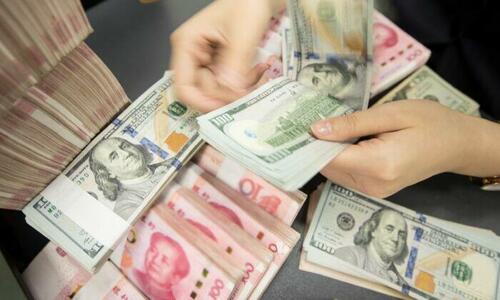The Biggest Problem China Faces Isn’t Real Estate
Authored by Christopher Balding via The Epoch Times,
After it joined the World Trade Organization in 2000 and anchored the Chinese yuan (a.k.a. renminbi) to the U.S. dollar, China linked its economy to the United States. Enforcing a fixed exchange rate regime with strict capital controls, China benefited from large inflows and relatively low-interest rates due largely to the low-interest rate environment in the United States. What happens to the Chinese economy when interest rates increase in the United States?
Sovereign currency policy faces the intractable dilemma of what economists call the “impossible trinity.” Countries can have a fixed exchange rate, free capital flow, or sovereign monetary policy but must choose only two of three. Economics textbooks give clean and clear definitions of each. Still, in reality, China tried to manipulate each and come out worse due to its attempts to manipulate the laws of economics.
Chinese Communist Party (CCP) technocrats attempted to create a system where they could enjoy the best of the three options and leave behind the worst parts. China implemented a quasi-fixed exchange rate, which is effectively a U.S. dollar index, with tightly controlled capital flows, and a semi-sovereign monetary policy.
What almost no one noticed with the convoluted creation of Chinese currency policy attempting to adhere to the ‘impossible trinity’ was that for the last 20 years, China benefited from business cycle synchronization with the United States. Because the yuan was tied directly to the U.S. dollar and the United States kept interest rates low, China could keep its interest rates low.
Now that the Federal Reserve (Fed) is raising interest rates, what impact will this have on China?
First, the days of easy money flows to China are over. For large parts of the last 20 years, Chinese interest rates were 3-5 percent higher than the United States. With either a fixed or sem-fixed exchange rate, this gave investors in China access to easy higher returns. With portfolio returns and foreign direct investment based upon interest rate differentials between the United States and China, this drew investor capital with fixed or heavily managed exchange rates creating easy returns. Investors have soured on China as an investment destination for a range of reasons. But when baseline returns are higher in U.S. government debt without any of the China issues, the financial motivation will dry up the biggest reason to send money.
Second, this will place enormous upward pressure on Chinese interest rates right as China’s economy is teetering. For most of the period since 2000, the Chinese and U.S. economies have been highly correlated. This allowed Chinese interest rates to follow the United States and enjoy a sustained period of low-cost money. However, now as the Fed is seeking to tamp down inflation and overheated demand, China is suffering through its weakest economy in probably post-opening up history. Rising interest rates with a teetering banking sector, high consumer debt, and a corporate sector suffering through a wave of defaults risk hyper charging a problem into a crisis. The People’s Bank of China (PBOC) faces a trade-off of whether to keep the yuan tied to the U.S. dollar and raise interest rates or reduce the link and let the yuan sink.
Third, rising U.S. interest rates will exacerbate capital outflow pressures from China. When Chinese government interest rates were 3-5 percent higher than in the United States, money flowed to China, seeking higher returns. Now short duration, U.S. government debt yields more than similar Chinese government debt. Add in the weak corporate sector and real estate pressures, and Chinese investors see many reasons to move their money out of China.
For countries like Japan or the United Kingdom, capital outflows mean declines in the currency. While China boasts $3 trillion in reserves, given the size of its economy and local financial market, that $3 trillion is actually a lot smaller than it appears. The United States now earns a higher rate of safe asset return with significantly less risk, and it becomes obvious why regulators warn banks and investors about moving capital out of China.
China tries to square the circle of financial policy by ignoring the realities of economic policy. Even as Chinese regulators recognize that the PBOC’s daily fixing price of the yuan deviated significantly from the weighted formula based upon the price of the U.S. dollar, they attempt little more than to plead with banks not to move from the official price. If U.S. interest rates remain above Chinese rates for a sustained period, this will force a change in Beijing policy in front of a set of circumstances not witnessed in modern history. Currently, Beijing is telling markets how to behave and price assets. That can only happen before markets find ways to move money or black markets that pay better prices.
Given the expected multi-year interest rate cycle and probable resulting U.S. dollar strength, Beijing must face some hard decisions. Does it raise interest rates to stem the fall of the yuan in the face of a teetering economy? Does it defend the yuan and clamp down on international financial flows even harder, given all the outward leaks?
Realistically, we should expect Beijing to delay any type of real decision as long as possible, given the very negative trade-offs it faces. Clamping down further on capital flows will only drive international investment away from an already unattractive destination. Raising interest rates risks taking the Chinese economy over the edge. However, doing nothing also presents risks if markets get spooked by teetering banks, falling asset prices, and a do-nothing approach from Beijing.
The reality is there are no good options, and Beijing will avoid that reality for as long as possible.
Tyler Durden
Mon, 10/03/2022 – 23:40

